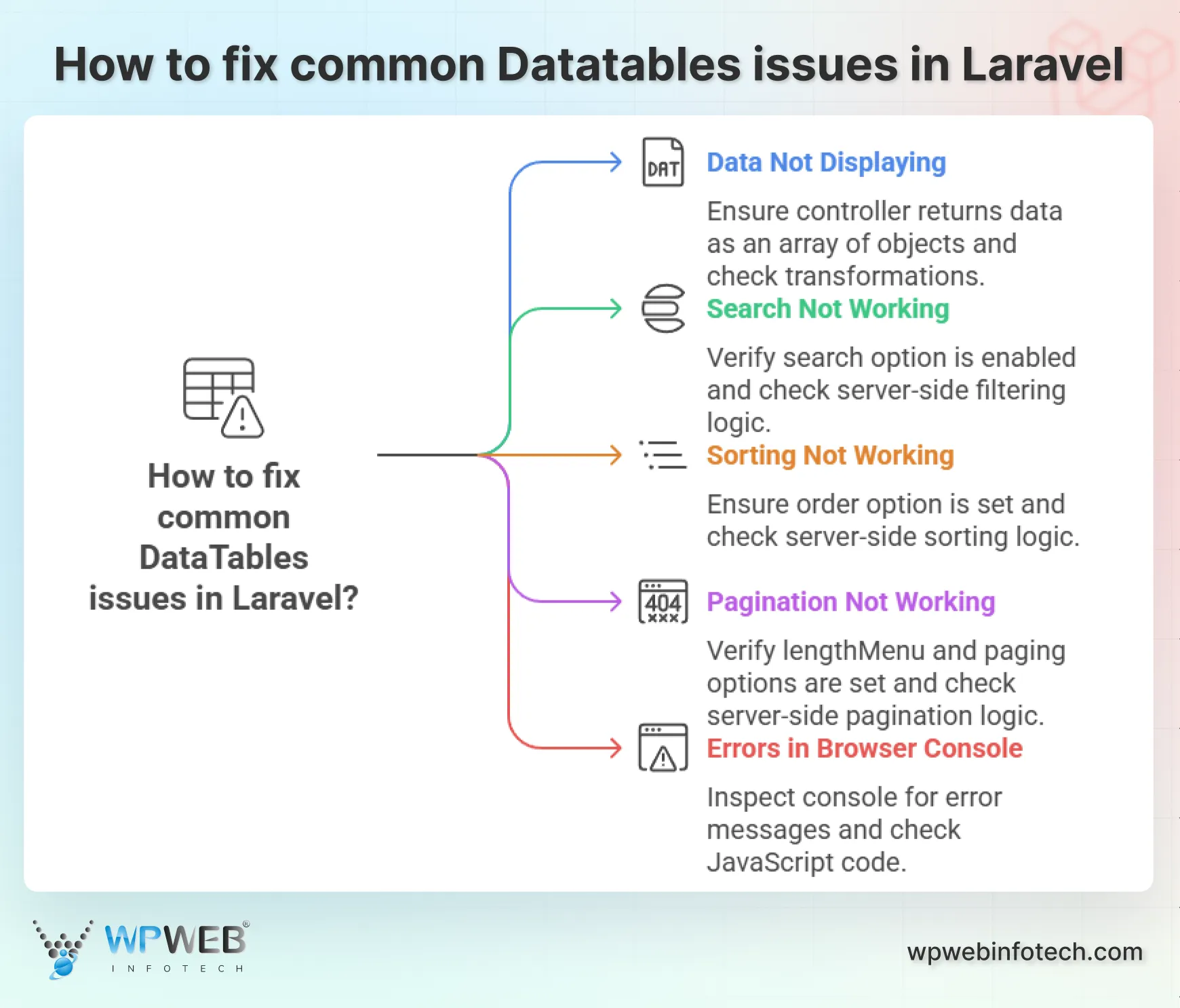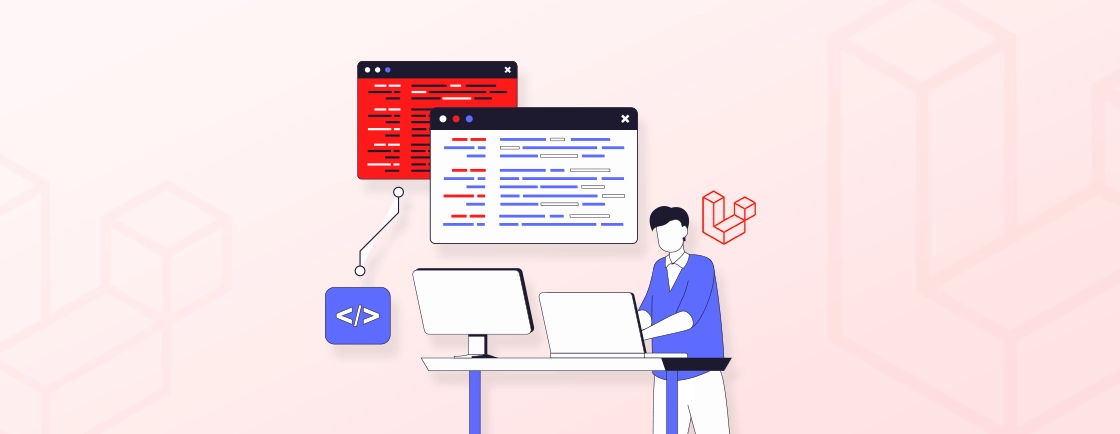Quick Summary
Discover how DataTables transforms static tables into interactive, user-friendly experiences in Laravel. This guide covers the importance of DataTables, their implementation using the yajra package, and how to enable features such as searching, sorting, pagination, and server-side processing for large datasets. Plus, troubleshoot common issues and optimize performance to elevate data handling in your Laravel applications.
Table of Contents
Datatables in Laravel make managing large datasets much easier. As the saying goes, ‘Data is the new oil.’ However, just as oil, if data isn’t refined, it won’t be usable. So, how do you manage overflowing data on your Laravel website? This is where DataTables come in. It’s a JavaScript library that transforms static HTML tables into interactive experiences.
Laravel DataTables provide users with the power to sort, search, and filter through information, making large datasets not only manageable but also user-friendly.
In this blog, we’ll discuss how to use DataTables in Laravel so you can enhance your website effortlessly. So, let’s dive in!
What are DataTables in Laravel?
In Laravel, DataTables is a powerful jQuery plugin. It enables advanced table functionalities such as pagination, searching, sorting, and more. This integration can be done through the use of the yajra/laravel-datatables package, which provides a seamless way to implement DataTables.
It also lets you do server-side processing with Laravel’s Query Builder or Eloquent ORM. This flexibility enables users to interact with large datasets for quicker results. Plus, Eloquent techniques simplify complex data handling while maintaining a visually appealing and accessible interface.
Why Use DataTables in Laravel?
Using DataTables in Laravel offers various advantages for handling and displaying large datasets efficiently. Here are several key reasons why integrating DataTables with Laravel is beneficial:

- Enhanced User Experience: DataTables transform static HTML tables into interactive components. Users can sort data by clicking headers, filter results with a search bar, and navigate through large datasets using pagination. This improves the overall experience for users interacting with your application’s data.
- Efficient Data Handling: Server-side processing allows you to handle large datasets efficiently. Filtering, sorting, and pagination happen on the Laravel server, reducing the load on the user’s browser and ensuring smooth performance.
- Reduced Code: Packages like Yajra DataTables provide a pre-built solution for common data table functionalities. This saves you significant development time compared to writing these features from scratch.
- Reduced Server Load: With client-side processing disabled, DataTables only fetches the necessary data based on user interaction (sorting, searching, pagination). This minimizes the amount of data transferred between the server and the client, leading to a more efficient application.
- Integration with Laravel Ecosystem: DataTables integrates seamlessly with Laravel’s core features like Eloquent ORM and Query Builder. You can leverage existing models and queries to have DataTables without writing complex data access logic.
- Customizability: You can define which data columns to display, how they should be formatted, and even add custom actions to your tables. This allows you to tailor the DataTables experience to your specific website needs.
The combination of DataTables with Laravel’s robust framework enables scalable data management solutions.
How to Implement DataTables in Laravel?
Implementing DataTables in Laravel involves several steps to integrate the DataTables jQuery plugin with Laravel’s backend. Here’s a structured guide on how to implement DataTables in Laravel:
Step 1: Install Laravel Project
Set up a new Laravel project or use an existing one where you want to integrate DataTables:
composer create-project laravel/laravel my-laravel-app
Step 2: Install DataTables Package
Use the yajra/laravel-datatables package, which simplifies the integration process. Install it via Composer:
composer require yajra/laravel-datatables-oracle
Here, we added the necessary package to facilitate DataTables integration within Laravel.
Step 3: Configure DataTables Package
Publish the configuration file for the DataTables package to customize settings as needed:
php artisan vendor:publish --provider="Yajra\DataTables\DataTablesServiceProvider" --tag=config
This step will create a datatables.php configuration file in your Laravel project’s config directory. Also, ensure you have a database setup with tables and data that you want to display using DataTables.
Step 4: Create a Model
If you haven’t already, create a model that corresponds to the table you want to display data from:
php artisan make:model YourModel
Replace YourModel with your actual model name. By creating a model, you can interact with database tables efficiently.
Step 5: Create a Controller
Generate a controller to handle DataTables logic. This controller will fetch and process data for DataTables:
php artisan make:controller DataTablesController
Within this controller, you will define methods to fetch data from the database using Eloquent or Query Builder.
Step 6: Define Routes
Define routes to handle DataTables AJAX requests in your routes/web.php file:
Route::get('data-tables-data', 'DataTablesController@data')->name('data.tables.data');
Adjust the route and controller method names as per your application’s needs. Establishing routes facilitates communication between DataTables frontend and Laravel backend.
Step 7: Create DataTables View
Create a Blade view file where DataTables will be rendered. For example, resources/views/datatables/index.blade.php.
Include the necessary DataTables scripts and stylesheets:
<!-- Include DataTables CSS and JS -->
<link rel="stylesheet" href="https://cdn.datatables.net/1.11.3/css/jquery.dataTables.min.css">
<script src="https://cdn.datatables.net/1.11.3/js/jquery.dataTables.min.js"></script>
Initialize DataTables in your view using jQuery:
<script>
$(document).ready(function() {
$('#dataTable').DataTable({
processing: true,
serverSide: true,
ajax: "{{ route('data.tables.data') }}",
columns: [
{ data: 'id', name: 'id' },
{ data: 'name', name: 'name' },
// Define more columns as per your table structure
]
});
});
</script>
Customize the columns array to match the columns of your database table. This will set up the front end to display DataTables with proper initialization and configuration.
Step 8: Implement Server-Side Data Handling
In your DataTablesController, define the data method to handle DataTables AJAX requests and return JSON data:
namespace App\Http\Controllers;
use App\Models\YourModel;
use Illuminate\Http\Request;
use Yajra\DataTables\Facades\DataTables; // Make sure to use this facade
class DataTablesController extends Controller
{
public function data(Request $request)
{
$data = YourModel::select('*'); // Or customize your query
return DataTables::of($data)->make(true);
}
}
Adjust the select() method to query specific columns as needed. Implementing server-side logic to fetch and process data for DataTables ensures efficient data handling.
Step 9: Test and Debug
Test your DataTables implementation to ensure data is fetched and displayed correctly. Use Laravel’s debugger to troubleshoot any issues that arise during implementation.
Step 10: Optimize and Customize
Customize DataTables appearance, behavior, and functionalities using DataTables options and plugins. To optimize it for performance you can use Laravel’s caching mechanisms. You must also make necessary changes to meet your specific website requirements and enhance user experience.
By following these steps, we’ve successfully implemented DataTables in our Laravel application. If you want to leverage the power of Laravel with DataTables, hire Laravel developers, who can help you perform all complex technical tasks.
Common Issues Using DataTables in Laravel and Their Fix
When using DataTables in Laravel, you may come across common issues, but they have straightforward fixes. Here are some problems you might encounter and their solutions:

Issue 1: Data Not Displaying in the DataTable
The controller method might not be returning the expected data format for DataTables.
Fix:
- Ensure your controller method returns data as an array of objects. Each object should represent a row in the DataTable and have properties corresponding to the database fields you want to display.
- Check if you’re applying any transformations to the data that might be causing issues with the format.
Now, your DataTable will display the fetched data correctly.
Issue 2: Search Not Working
You might not have enabled searching in the DataTables initialization, or the server-side filtering logic might be malfunctioning.
Fix:
- Verify that the search option is set to true during DataTables initialization in your Blade template.
- If using server-side searching, double-check your controller method to ensure it applies search filters correctly based on user input.
By fixing this issue, users can search the DataTable effectively to find specific data.
Issue 3: Sorting Not Working
Sorting might not be enabled in the DataTables initialization, or the controller method might not be handling sorting requests.
Fix:
- Make sure the order option is set during DataTables initialization. This allows users to click on column headers for sorting.
- If using server-side sorting, ensure your controller method sorts the data based on the sorting information received from DataTables (sorting column and direction).
Users will be able to sort the datasets by different columns, allowing them to organize data as needed.
Issue 4: Pagination Not Working
Pagination might not be enabled in the DataTables initialization, or your controller method might not be handling pagination requests properly.
Fix:
- Verify that the lengthMenu and paging options are set during DataTables initialization. These options define the number of records per page and enable pagination controls.
- If using server-side pagination, ensure your controller method limits the number of records returned based on the current page and total records.
Now, users can navigate through large datasets efficiently using the pagination controls.
Issue 5: Errors in the Browser Console
There might be JavaScript errors in your code related to DataTables initialization or custom functionalities.
Fix:
- Inspect the browser console for any error messages related to DataTables. These messages can provide clues about the root cause of the issue.
- Check your JavaScript code for syntax errors or conflicts with other libraries.
By fixing the JavaScript errors, you ensure the DataTable functions as intended.
By understanding these common issues, you can effectively troubleshoot and maintain your DataTables implementation in Laravel. It will result in a well-functioning and user-friendly data exploration experience.
FAQs About Implementation of DataTables in Laravel
Can I use Datatables in Laravel for large datasets?
Yes, DataTables uses server-side processing, which means data is only loaded into the table as needed. This allows for efficient handling of large datasets without slowing down performance. Additionally, it offers various features such as pagination and searching to help manage large datasets.
Is it possible to integrate Datatables into an existing Laravel project?
Yes, it is possible to integrate Datatables into an existing Laravel project. The process involves installing the DataTables package, configuring it, and implementing the necessary views and routes. With proper configuration, DataTables can seamlessly integrate into an existing Laravel project.
Can Datatables be customized in Laravel?
Yes, DataTables can be customized in Laravel to fit the specific needs of a project. This can be done by modifying the configuration and using various options and plugins provided by DataTables. Additionally, custom Javascript and CSS can be added to further customize the appearance and functionality of Datatables.
Conclusion
DataTables in Laravel involves setting up the DataTables package, configuring routes and controllers, creating views, and handling data retrieval and display. By following these steps and leveraging Laravel’s powerful features, you can efficiently integrate DataTables to enhance the interactivity and user experience of your Laravel applications.
Implementing DataTables in your Laravel application enhances how you handle and display data. The process of implementation involves configuring routes and controllers, creating views, and handling data retrieval and display. To enable your site users to sort, filter, and navigate through datasets effortlessly, connect with Laravel development services now!
Enhance Your Laravel Projects with Advanced DataTables Integration
Learn how to use DataTables in Laravel for dynamic, fast, and user-friendly data handling.





